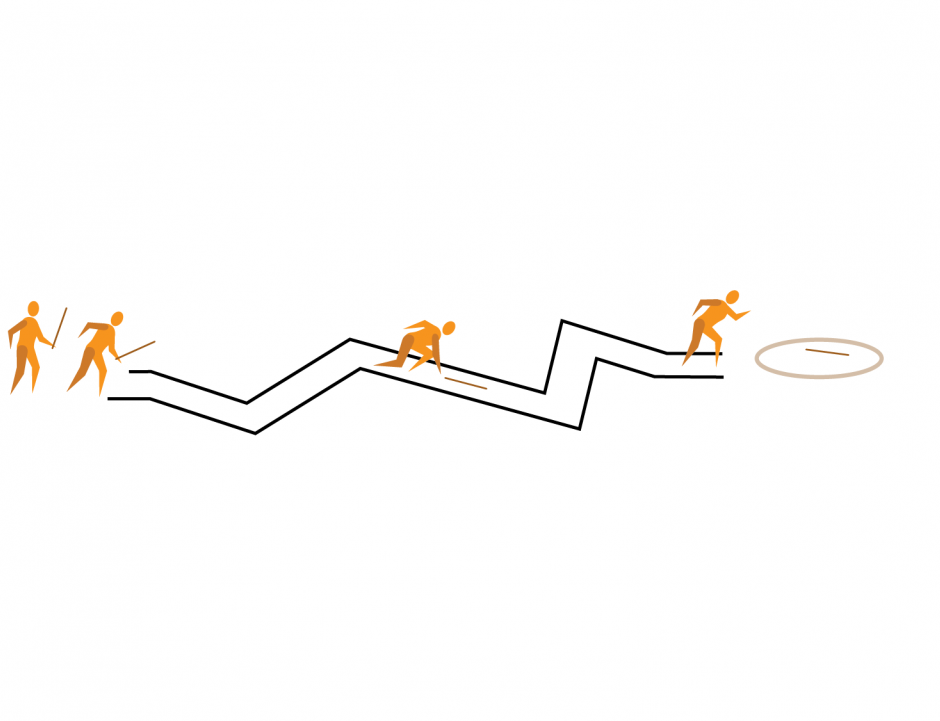TGfU Category: Target Games
Locations: gymnasium, multipurpose room, hallway, outdoor space (e.g., field, tarmac)
Game/Sport Connections
Target games are activities in which players send an object toward a target while avoiding any obstacles. By playing these games, participants develop skills and tactics to play other target games or games that require the application of similar skills, concepts, and strategies (e.g., archery, bocce, bowling, croquet, curling, golf, horseshoes, shuffleboard, Snow Snake).
Activity Overview
Participants learn about and practise sending an object through a designated course and toward a target.
Key Movement Skills, Concepts, and Strategies
Throughout the activity, consider highlighting the following skills, concepts, and strategies for effectively sending an object toward a target. Note that this list is not exhaustive and further learning opportunities may arise during the task.
Movement Skills and Concepts
- Manipulation skills and effort awareness: applying an appropriate level of force to send the object in a specific direction (e.g., sliding the stick with a controlled force so that it goes through a designated course).
- Body and spatial awareness: knowing what parts of the body move and how to move them (e.g., bending the body into a low position while moving the arm and flicking the wrist to slide the stick across the floor).
Movement Strategies
Decision making: learning to make appropriate decisions at different points of the game (e.g., when approaching a narrow portion of the course, deciding to apply a lighter force when sliding the stick).
Considerations
- Incorporate some or all of the variations listed in the “Variations” section while planning the activity. This will help to best meet the diverse backgrounds, identities, needs, and interests of participants and maximize the fun, inclusion, participation, and success of everyone.
- To elevate participant voice and choice, periodically pause the activity and share the variations with participants. Ask them to determine how they would like to change the activity to maximize the fun, inclusion, meaningful participation, and success for everyone. Encourage participants to add any variations of their own.
Equipment
- 1 object to send per participant (e.g., wooden craft stick, dowel rod, ruler, metre stick, disc, beanbag, rubber chicken, various sizes and textures of balls)
- 1 target per group (e.g., hula hoop, pylon, garbage can)
- Floor markers per group (e.g., rubber/vinyl spots, cones, pylons, skipping ropes, tape)
Safety
- Inspect the equipment and activity area to identify and remove hazards. Check that the activity surface provides sufficient traction.
- Establish the boundaries for the designated playing area at a safe distance from walls and obstacles. Share the boundaries with participants.
- Review the safety rules and activity instructions with participants prior to the activity.
- Instruct participants to be aware of their surroundings, including the locations of other participants during play.
How to Play
- Divide participants into small groups (e.g., 4 – 6).
- Assign groups to a playing area.
- Groups create a course that includes a zigzag pattern using floor markers (e.g., rubber/vinyl spots, cones, pylons, skipping ropes, tape). They then set up a target (e.g., hula hoop, pylon, garbage can) at the end of the course.
- Each participant chooses an object to send (e.g., twig, wooden craft stick, dowel rod, ruler, metre stick, disc, beanbag, rubber chicken, various sizes and textures of balls). Participants may change their sending object each time they complete the course.
- Participants form a line at the start of their course. In turn, each participant places their object on the floor and uses their hand or foot to slide the object along the floor to navigate it through their course.
- When participants reach the end of the course, they send the object to the target.
- Participants count how many slides it takes to complete the course.
- If a participant makes contact with the course markers with their object or if their object goes out of bounds, they start again at the beginning of the course. By agreement, participants can choose to return to their previous position on the course if their object hits course markers or goes out of bounds.
- Participants may change their course (e.g., making a longer or narrower course with more difficult turns) after each participant has completed the course or at any time during the activity.
- After a period of play, provide participants with some or all of the variations. Ask them to decide how they might change the game to enhance their fun, challenge, and success. Encourage participants to add any variations of their own.
- Consider having groups share their variations and select another variation to try with their group.
Image: Visual Depiction of the Activity Instructions

Pause for Learning
Throughout the activity, ask open-ended questions to help participants refine their movement skills, strategies, and tactical solutions. Examples include:
- What types of force do you use to send your object at different parts of the course and why?
- Which part of the course is more/less challenging for you and why?
- What do you do to control your object’s movements to avoid your object making contact with the course markers or going out of bounds?
- Why is it important to be aware of your playing environment before choosing a sending object?
- Which games or sports have you played or know about that use similar rules and strategies to the ones used in this game?
Variations
- Work in pairs or as a group to complete the course.
- Have groups make courses for other groups to attempt.


